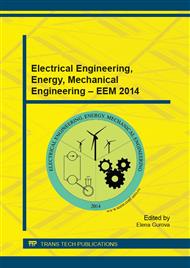[1]
Y. Chengwu, X. Binshi, Zh. Xiancheng, Interface microstructure and mechanical properties of laser welding copper - steel dissimilar joint, Opt. Laser Eng. 47 (2009) 807-814.
DOI: 10.1016/j.optlaseng.2009.02.004
Google Scholar
[2]
G.A. Turichin, O.G. Klimova, K.D. Babkin, Ya.B. Pevzner, Effect of thermal and diffusion processes on formation of the structure of weld metal in laser welding of dissimilar materials, Metal Sci. heat Treat. 55 (2014) 569-574.
DOI: 10.1007/s11041-014-9671-7
Google Scholar
[3]
E. Taban, J.E. Gould, J.C. Lippold, Dissimilar friction welding of 6061-T6 aluminum and AISI 1018 steel: Properties and microstructural characterization, Mater. Design. 31 (2010) 2305-2311.
DOI: 10.1016/j.matdes.2009.12.010
Google Scholar
[4]
N.R.J. Hynes, P. Nagaraj, J.A.J. Sujana, Mechanical Evaluation and Microstructure of Friction Stud Welded Aluminium-Mild steel Joints, Arabian J. Sci. Eng. 39 (2014) 5017-5023.
DOI: 10.1007/s13369-014-1082-y
Google Scholar
[5]
W. Chuaiphan, S. Chandra-ambhorn, S. Niltawach, B. Sornil, Dissimilar Welding between AISI 304 Stainless Steel and AISI 1020 Carbon Steel Plates, Appl. Mechanics and Mater. 268-270 (2013) 283-290.
DOI: 10.4028/www.scientific.net/amm.268-270.283
Google Scholar
[6]
I. Hajiannia, M. Shamanian, M. Kasiri, Microstructure and mechanical properties of AISI 347 stainless steel/A335 low alloy steel dissimilar joint produced by gas tungsten arc welding, Mater. Design. 50 (2013) 566-573.
DOI: 10.1016/j.matdes.2013.03.029
Google Scholar
[7]
P. S. A. A. Akbari Mousavi, P.F. Sartangi, Experimental investigation of explosive welding of cp-titanium/AISI 304 stainless steel, Mater. Design. 30 (2009) 459-468.
DOI: 10.1016/j.matdes.2008.06.016
Google Scholar
[8]
A.A. Nikulina, A.A. Bataev, A.I. Smirnov, Structural research of flash butt welded joints of workpieces from dissimilar steels, Obrabotka metallov (tekhnologiya, oborudovanie, instrumenty) (in rus) 47 (2010) 23-28.
Google Scholar
[9]
V.R. Rybov, D.M. Rabkin, R.S. Kurochko, Welding of dissimilar metals and alloys, Mashinostroenie, Moscow, (1984).
Google Scholar
[10]
Welding Engineering Handbook in 4 vol., in: A.I. Akulov (Ed. ), Mashinostroenie, Moscow, (1978).
Google Scholar
[11]
I. Bataev, A. Bataev, V. Mali, V. Burov, E. Golovin, A. Smirnov, E. Prikhodko, Structure and fatigue crack resistance of multilayer materials produced by explosive welding, Adv. Mater. Res. 287-290 (2011) 108-111.
DOI: 10.4028/www.scientific.net/amr.287-290.108
Google Scholar
[12]
C. Sudha, T.N. Prasanthi, S. Murugesan, Study of interface and base metal microstructures in explosive clad joint of Ti-5Ta-1. 8Nb and 304L stainless steel, Sci. Technol. welding and joining. 16 (2011) 133-139.
DOI: 10.1179/1362171810y.0000000001
Google Scholar
[13]
I. A. Bataev, A.A. Bataev, V.I. Mali, D.V. Pavliukova, Structural and mechanical properties of metallic-intermetallic laminate composites produced by explosive welding and annealing, Mater. design. 35 (2012) 225-234.
DOI: 10.1016/j.matdes.2011.09.030
Google Scholar
[14]
Iu.N. Maliutina, V.I. Mali, I.A. Bataev, A.A. Bataev, M.A. Esikov, A.I. Smirnov, K.A. Skorokhod, Structure and microhardness of Cu-Ta joints produced by explosive welding, The Scientific World J. 2013 (2013) 1-7.
DOI: 10.1155/2013/256758
Google Scholar
[15]
A.A. Nikulina, V. Yu. Skeeba, E.E. Kornienko, E.N. Mironov, Simulation of structurization in the welded joint between dissimilar steels, Obrabotka metallov (tekhnologiya, oborudovanie, instrumenty) (in rus) 53 (2011) 54-61.
Google Scholar
[16]
V.A. Bataev, A.A. Nikulina, A.A. Bataev, The investigation of fracture processes of heterogeneous steels joined by the method of contact welding, Proceedings of IFOST-2008 - 3rd International Forum on Strategic Technologies 3rd International Forum on Strategic Technologies, IFOST-2008. Novosibirsk-Tomsk, 2008. pp.75-76.
DOI: 10.1109/ifost.2008.4603003
Google Scholar
[17]
A.A. Nikulina, V.G. Burov, A.A. Bataev, V.A. Bataev, Microstructure of the welded joints of frog and rail, Obrabotka metallov (tekhnologiya, oborudovanie, instrumenty) (in rus) 34 (2007) 32-34.
Google Scholar
[18]
E. Kutelia, T. Dzigrashvili, Interpretation of electron diffraction patterns of two-phase and twinned crystals, Intellekty, Tbilisi, (2005).
Google Scholar


